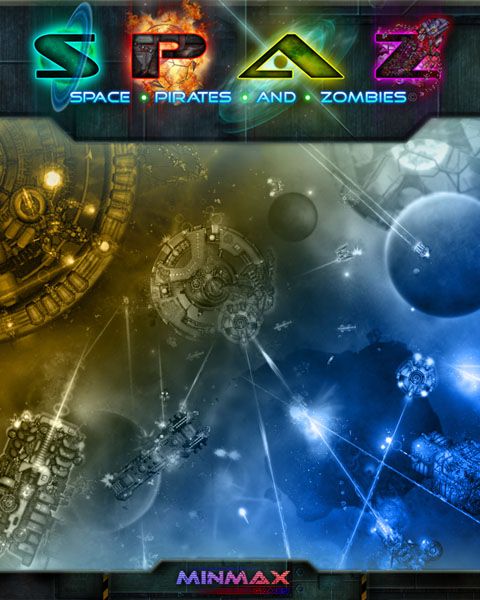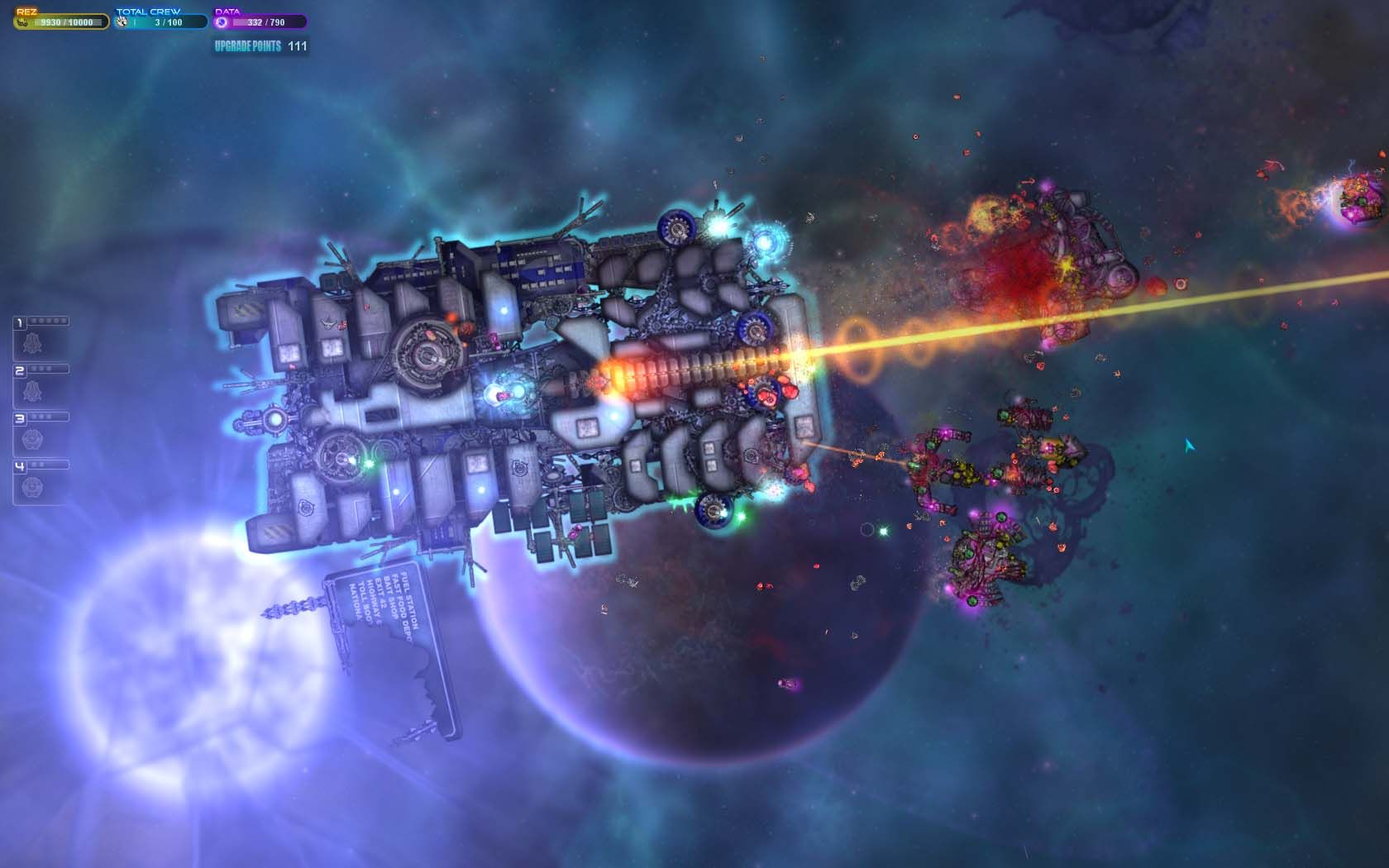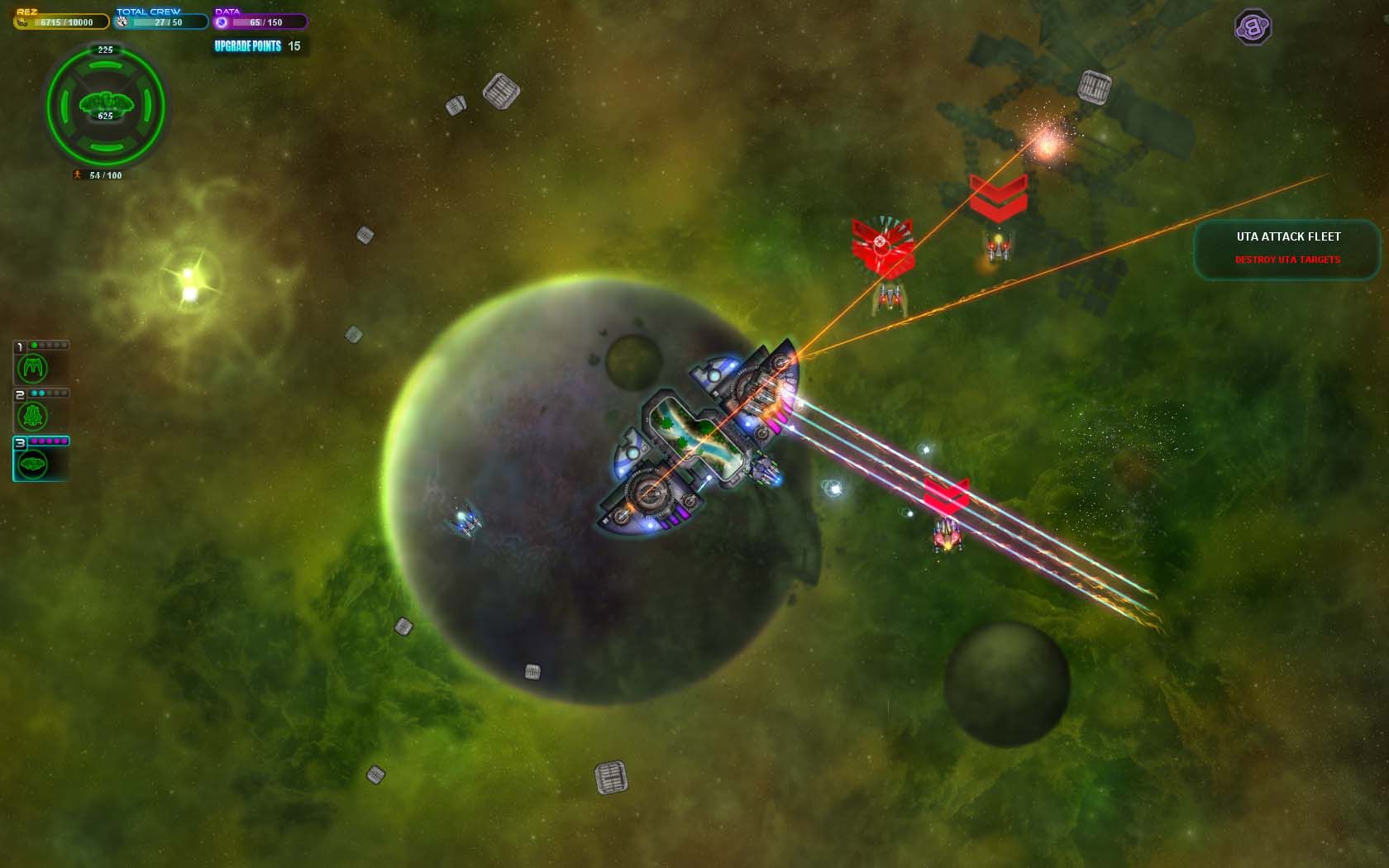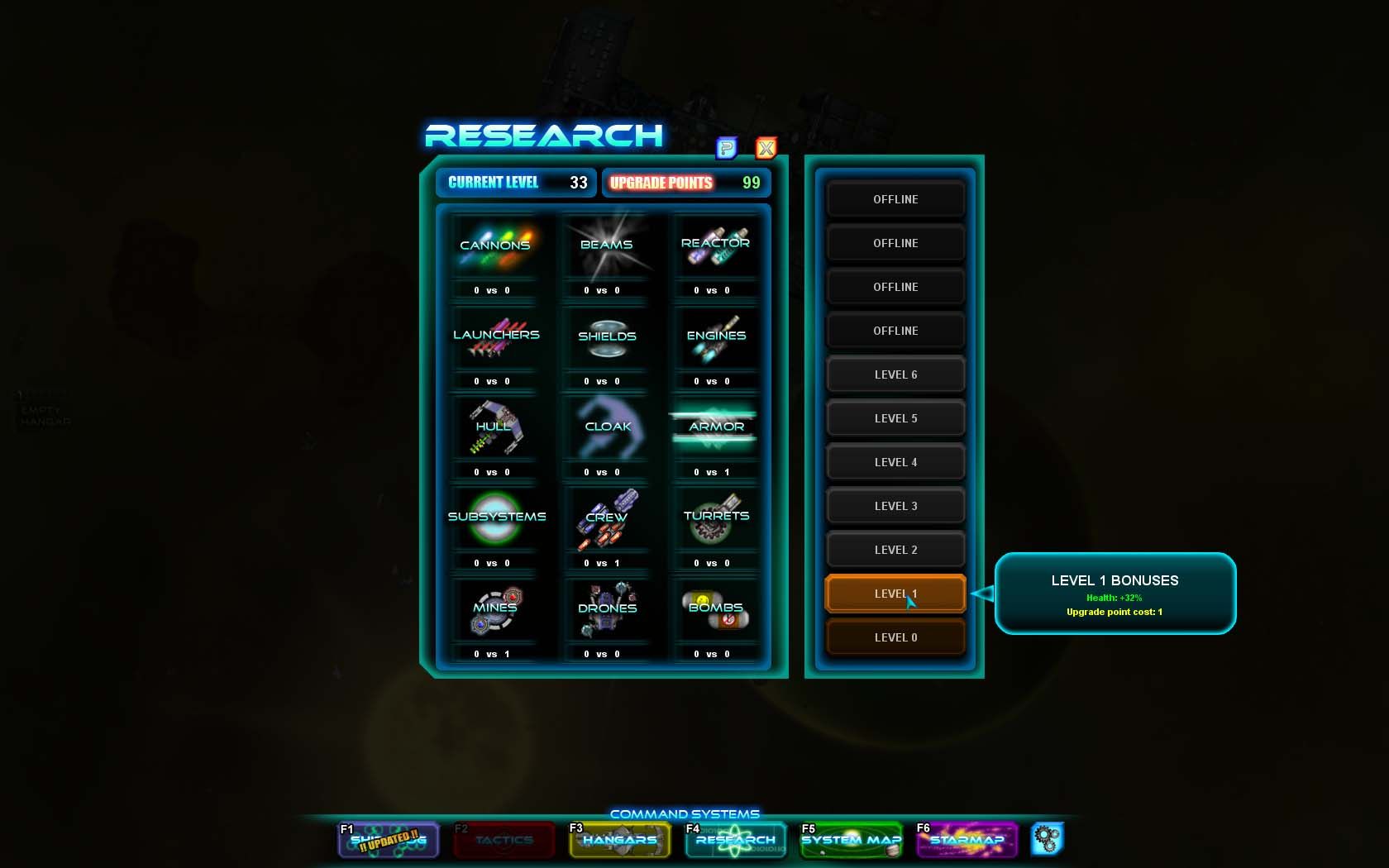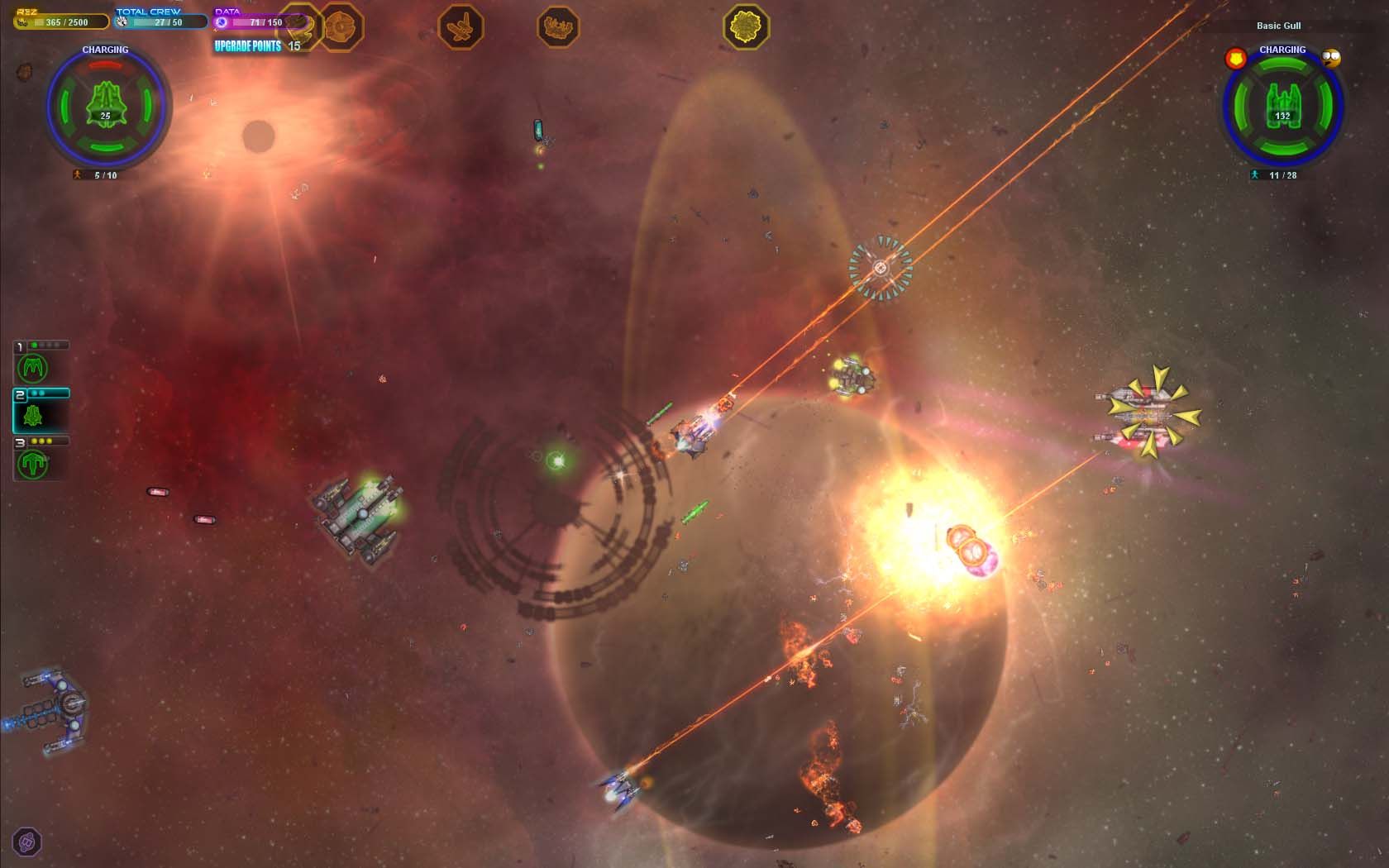I jumped at the chance to play Space Pirates and Zombies after our own Allen Park described the basics of it to me. Developed by a small team of two people, Space Pirates and Zombies (or SPAZ as it is consistently abbreviated), is a hybrid of a few different game types that I have always enjoyed. SPAZ combines elements of old-school, 2D, top-down shoot-em-ups; space exploration; mild RPG elements and a wicked and often cynical sense of humor to create what is the best indie title I’ve personally played this year. But, most of all, it resembles one of my favorite games of the 90s, a small Mac game where you explored space, bought new ships and weapons and had a free run though space called Escape Velocity. SPAZ is not nearly as deep as Escape Velocity was, however it is still a lot of fun and lasts quite a while.
The game begins with a humble message from the two developers thanking you for purchasing their game and then quickly moves on to load all art assets. The result is a game that once loaded, does not need to load again. This is particularly cool considering each system is randomly generated. In fact, the entire galaxy you play in is randomly generated when you first begin. While I wish that it meant more, the random generation of the galaxy and systems just means that things will be slightly moved around should you choose to start a new game.
That said, the actual art and design aspects of the game are great. The backgrounds, while all mostly similar are bright and lively, often with humorous signs or strange structures. Each ship has an interesting design, though there are not a large amount of ships. Each of the ships look lively as they move through space, with blinking lights and glittering engine trails. However, the ships tend to look their best when they’re in battle, as cannons, lasers and missiles of all colors are launched from the ships. The vessels break apart and show their battle damage as they battle it out. The damage the various space ships show is actually one of my favorite aspects of the game, and aside from looking great, is a prime example of the excellent visual clues the game throws in to streamline the interface. Of course you still have the option to check around your screen to see the shield strength of enemy ships, but it really is unnecessary, unless you’re fighting something huge, like a space station.
The little visual cues are all throughout the game as well. The most practical is the way your engine trail can shift to help you determine which direction you’re moving in. The whole game is filled with little visual treats too. Hit a spaced person, and they will literally pop. It is dark and amusing.
The controls work surprisingly well, even if they don’t behave quite as intuitively as you’d expect. Your selected ship is moved with the WASD keys, and you aim your ship with the mouse. It works better than you would expect, though it can get a bit confusing during combat. Still, you can easily get used to the controls so this becomes less of a problem as time goes on. While you only control one ship in your small fleet at any given time, you can switch to the others very easily by pressing the corresponding number on your keyboard.
The AI that controls the other ships in your fleet is surprisingly competent, though not perfect. The friendly AI is roughly on par with the enemy AI, so everything feels balanced. By this I mean there was a time or two where the enemy ships would attack my smaller ships instead of the larger ones that were rapidly destroying them, or they would not even attack at all. These little AI twists did not happen often though.
The story of SPAZ is nothing amazing, though it is filled with some humorous text. The plot is basically a way to give players the various missions, which often involve collecting. In fact, collection is often the primary object of the game. In addition to collecting mission items, you will constantly be collecting the three main resources in the game; Rez, Goons and Data. Rez is essentially the basic interstellar currency and is also used as the resource for which to rapidly rebuild your ships when they are destroyed. Goons are people that you gather from escape pods after you destroy a ship and can be used either as currency to repair relations with a faction or kept on your ships to repair them faster in combat. Certain Goons act almost as leaders, and can be assigned to your fleet to boost various things. While some are found randomly, others are granted as a reward for some of the various side missions. Finally, the last of the three main collectables is Data, which is SPAZs measurement for experience. Experience is then exchanged for new levels in various skills, such as beams, missiles or other ship components. You also collect blueprints for ships and weapons, though these are much rarer than the other drops.
The actual missions are often short and don’t overstay their welcome, as each individual solar system is independent from each other. Each system has two primary factions fighting each other, the UTA or the Civilians. There is no real difference in each faction aside from the ships they use and the fact that the UTA always controls the warp gates in that sector. Even the various side missions are generally similar between the two factions.
The faction relationships do not carry over and remain inconsistent from system to system. This has a dual effect, it does not screw you over if you anger one faction, but it also means there are no real effects for helping one side over another, unless you count the immediate benefit of opening up a shop or a warp gate. The decision to keep each solar system separate also gives the game a leisurely pace. Each system is ranked according to suggested player level, so you can see if you might need to grind a bit before taking on a new system.
The shorter mission style and leisurely pace of the game is actually great, and really extends the gameplay of the game. While the game is not really fun in long bursts, as the gameplay itself is pretty repetitive, it stays fun by being best in chunks. I’ve been playing the game over a series of months. I have been able to avoid getting tired of the game mostly because SPAZ is at its best when it is being played an hour or so at a time. There were times when I played for much longer, but at an hour or so a session, the game’s fun can really last.
Overall, I had a lot of fun with Space Pirates and Zombies. It is not perfect, but it certainly can be fun. It is not for everyone, but those who want a bit of an old school space exploration game are in for a treat. It has been years since I have played a game like this, and I wish it was deeper. The two guys who make up MinMax Games have clearly worked hard to create something special, and they are continuing to do so. There is a list of planned additions that includes bounty hunters and more ships, so if you do pick it up, you can easily expect more content. I wish the devs would port this to a handheld, as the setup of the game is perfect for quick gaming sessions, as well as longer ones. It runs smoothly and aside from seeing art assets over and over, the game still looks great. Overall I had a blast with SPAZ, and can strongly suggest picking it up if you have any interest in this kind of RPG-Hybrid Space Exploration game.

